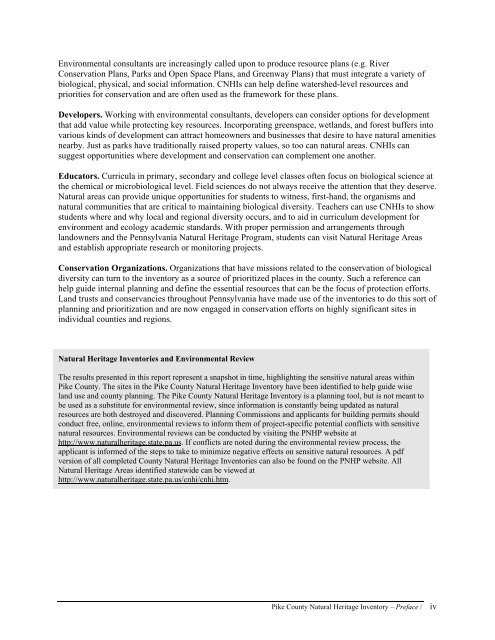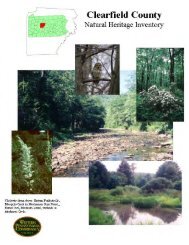Pike CNHI - Pennsylvania Natural Heritage Program
Pike CNHI - Pennsylvania Natural Heritage Program
Pike CNHI - Pennsylvania Natural Heritage Program
You also want an ePaper? Increase the reach of your titles
YUMPU automatically turns print PDFs into web optimized ePapers that Google loves.
Environmental consultants are increasingly called upon to produce resource plans (e.g. River<br />
Conservation Plans, Parks and Open Space Plans, and Greenway Plans) that must integrate a variety of<br />
biological, physical, and social information. <strong>CNHI</strong>s can help define watershed-level resources and<br />
priorities for conservation and are often used as the framework for these plans.<br />
Developers. Working with environmental consultants, developers can consider options for development<br />
that add value while protecting key resources. Incorporating greenspace, wetlands, and forest buffers into<br />
various kinds of development can attract homeowners and businesses that desire to have natural amenities<br />
nearby. Just as parks have traditionally raised property values, so too can natural areas. <strong>CNHI</strong>s can<br />
suggest opportunities where development and conservation can complement one another.<br />
Educators. Curricula in primary, secondary and college level classes often focus on biological science at<br />
the chemical or microbiological level. Field sciences do not always receive the attention that they deserve.<br />
<strong>Natural</strong> areas can provide unique opportunities for students to witness, first-hand, the organisms and<br />
natural communities that are critical to maintaining biological diversity. Teachers can use <strong>CNHI</strong>s to show<br />
students where and why local and regional diversity occurs, and to aid in curriculum development for<br />
environment and ecology academic standards. With proper permission and arrangements through<br />
landowners and the <strong>Pennsylvania</strong> <strong>Natural</strong> <strong>Heritage</strong> <strong>Program</strong>, students can visit <strong>Natural</strong> <strong>Heritage</strong> Areas<br />
and establish appropriate research or monitoring projects.<br />
Conservation Organizations. Organizations that have missions related to the conservation of biological<br />
diversity can turn to the inventory as a source of prioritized places in the county. Such a reference can<br />
help guide internal planning and define the essential resources that can be the focus of protection efforts.<br />
Land trusts and conservancies throughout <strong>Pennsylvania</strong> have made use of the inventories to do this sort of<br />
planning and prioritization and are now engaged in conservation efforts on highly significant sites in<br />
individual counties and regions.<br />
<strong>Natural</strong> <strong>Heritage</strong> Inventories and Environmental Review<br />
The results presented in this report represent a snapshot in time, highlighting the sensitive natural areas within<br />
<strong>Pike</strong> County. The sites in the <strong>Pike</strong> County <strong>Natural</strong> <strong>Heritage</strong> Inventory have been identified to help guide wise<br />
land use and county planning. The <strong>Pike</strong> County <strong>Natural</strong> <strong>Heritage</strong> Inventory is a planning tool, but is not meant to<br />
be used as a substitute for environmental review, since information is constantly being updated as natural<br />
resources are both destroyed and discovered. Planning Commissions and applicants for building permits should<br />
conduct free, online, environmental reviews to inform them of project-specific potential conflicts with sensitive<br />
natural resources. Environmental reviews can be conducted by visiting the PNHP website at<br />
http://www.naturalheritage.state.pa.us. If conflicts are noted during the environmental review process, the<br />
applicant is informed of the steps to take to minimize negative effects on sensitive natural resources. A pdf<br />
version of all completed County <strong>Natural</strong> <strong>Heritage</strong> Inventories can also be found on the PNHP website. All<br />
<strong>Natural</strong> <strong>Heritage</strong> Areas identified statewide can be viewed at<br />
http://www.naturalheritage.state.pa.us/cnhi/cnhi.htm.<br />
<strong>Pike</strong> County <strong>Natural</strong> <strong>Heritage</strong> Inventory – Preface / iv










